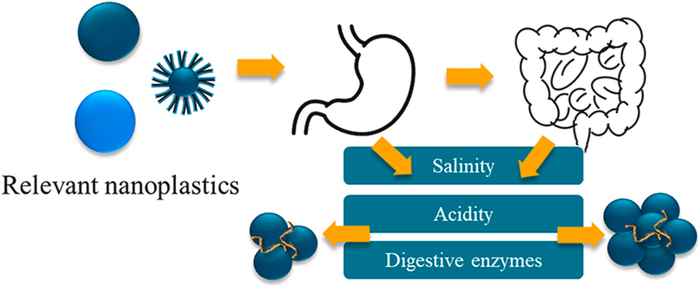What if you eat nanoplastics? A laboratory exploration of their gastrointestinal digestion
Nanoplastics agglomerate thanks to human digestive enzymes
28 October 2024

The research was carried out in a cooperation between researchers at the Analytical Chemistry group (PhD candidate Maria Hayder, Dr Alina Astefanei), the Industrial Sustainable Chemistry group (Prof. Gert-Jan Gruter) , both at the Van ‘t Hoff Institute for Molecular Sciences (HIMS), and Prof. Annemarie van Wezel of Environmental Ecology at the Institute for Biodiversity and Ecosystem Dynamics (IBED).
Since the study concerns a laboratory simulation using a simplified model of human gastrointestinal tract, its results cannot be extrapolated to predict any actual health effect of nanoplastics. The research does, however, provide insight into a crucial aspect of understanding nanoplastics’ health risk: the fate of nanoplastics in the digestive system. The Chemosphere paper provides a solid technical foundation for investigating this. It presents a dedicated set of analytical approaches for the characterization of nanoparticles and their agglomerates.
Digestive enzymes promote agglomeration
One of the more important observations was that the smaller the particles, the greater their tendency to agglomerate in the environment of the human stomach and intestine. This is aided by the presence of digestive enzymes, that are secreted by our gastrointestinal tract. Since such agglomeration increases the effective size of the ingested nanoplastics, this potentially reduces their ability to pass through cell membranes. More surprisingly, the study revealed that even more ‘stable’ types of nanoplastics are affected by digestion. These also agglomerate due to their interaction with the digestive enzymes, and eventually reach the same size as the ‘less stable’ ones.
The study focused on a set of nanoparticles of different composition, size and surface as model representatives of real-life nanoplastics contamination. To make the study possible, these were used in higher concentrations than what would typically be ingested by humans. This allowed the researchers to observe trends that indicate what can be expected in actual digestion of nanoplastics.
By establishing such trends the researchers have demonstrated the value of their set of analytical approaches. They emphasize, however, that nanoplastics analysis is still in its infancy, and requires and deserves further investigation.
Abstract, as published with the paper
Despite our growing awareness of micro-and nanoplastics presence in food and beverages, the fate of nanoplastics (NPs) in the human gastrointestinal tract (GIT) remains poorly investigated. Changes of nanoplastics size upon digestive conditions influence the potential of absorption through the intestine. In this study, polymer nanoparticles with different physicochemical properties (size, surface and chemistry) were submitted to gastrointestinal digestion (GID) simulated in vitro. Their agglomeration behaviour was measured with a unique set of analytical approaches, allowing to study NPs’ interactions with the digestive enzymes. Smaller NPs agglomerated more, narrowing the overall particle size distribution of smaller and larger NPs. NPs of different polymers exhibited heteroagglomeration. Digestive enzymes interact with the NPs, forming large but fragile agglomerates. In presence of the enzymes, even acid-functionalized NPs, typically stable in harsh conditions, agglomerated similarly to the non-functionalized PS NPs. These results highlight the role of the GID in increasing the effective size of ingested NPs, potentially reducing their ability to pass through the cell membranes. Our findings address a critical knowledge gap in nanoplastics oral uptake potential, providing a solid technical foundation for their characterization.
Paper details
Maria Hayder, Annemarie P. van Wezel, Gert-Jan M. Gruter, Alina Astefanei: What if you eat nanoplastics? Simulating nanoplastics fate during gastrointestinal digestion. Chemosphere, Volume 365, October 2024, 143277. DOI: 10.1016/j.chemosphere.2024.143277